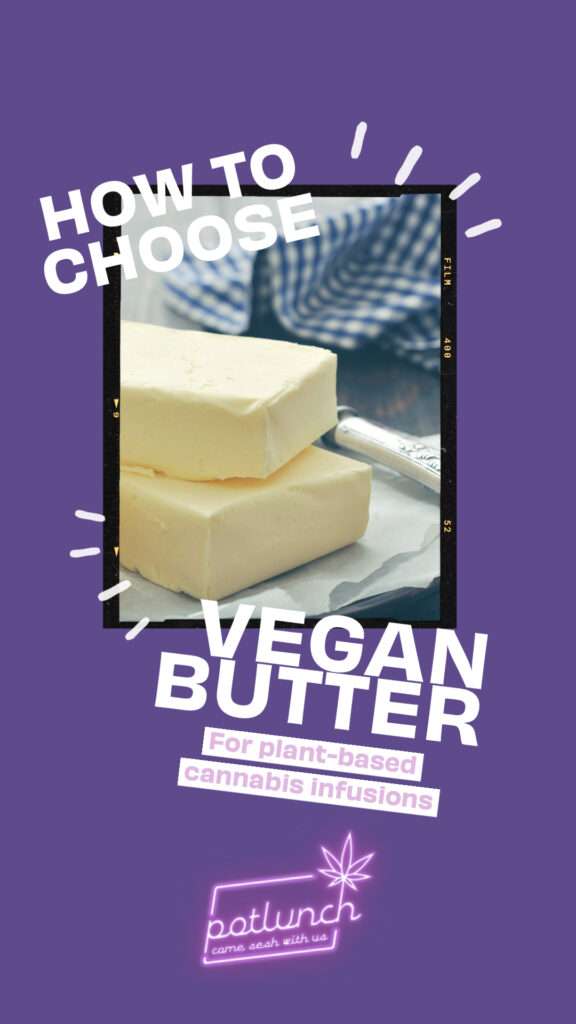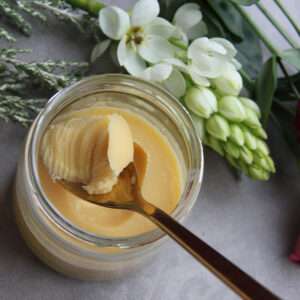Although I’m a very pro butter cook, I understand that dietary restrictions, medical complications, and lifestyle choices can exclude a lot of people from wanting to make cannabis-infused foods. More often than not, our first experiences with making cannabis-infused foods at home include stumbling through a cannabutter recipe. If you can’t have dairy butter, for whatever reason, what are your options for making that kind of infusion at home? Coconut oil is often touted as a solid replacement for butter. In my opinion, coconut oil is fantastic for a lot of recipes, but it’s not always great as a straight-up butter replacement. Today I’m going to go over what to look for in a plant-based butter and how to infuse it for your own dairy-free or vegan infused treats.
Can I use plant butter or vegan butter to make cannabutter?
The short answer is a resounding: YES!
As I often mention in blog posts and Pot Lunch episodes, cooking with cannabis is incredibly flexible– don’t let anyone tell you otherwise. There are very few “rules” when it comes to cannabis infusions.
Plant-based and vegan butter are excellent alternatives to dairy butter or coconut oil.
As practical, coconut oil is not a perfect replacement for butter. Sometimes you need or want that flavor that coconut oil will never be. Or you’re making a recipe that needs extra moisture. Luckily, it’s 2022, and most grocery stores have half a shelf dedicated to plant butter.
What to look for on the nutrition label
The first thing to look at is total fat. Dairy butter has 12g of total fat and 7g of saturated fat per tablespoon. Coconut oil has 12g of fat, and almost 10g is saturated fat. Therefore, plant butter should be close to 12g and 7g.
In my searches at the grocery stores, I found many had about the same amount of total fat but much less saturated fat. Of course, the more saturated fat the plant butter has, the better it will be for infusions.
If you looked at saturated and unsaturated fat at the molecular level, you’d see that saturated fat is much more dense and compact than unsaturated. Saturated fat is called so because each carbon atom is saturated with hydrogen creating dense straight chains of molecules. Unsaturated fat has no hydrogen atoms and leggy and often crooked chains. The density of saturated fat allows it to soak up more THC molecules.
Vegetable oils like olive oil, or canola, are significantly lower in saturated fat, and that is typically what plant-based or vegan butters are made with. You should try to look for blends that also have some coconut oil.
You should also make sure that the plant-based butter you choose is UNSALTED.
The lecithin thing
One thing to be aware of is that many plant-based butter products have a small amount of lecithin. Some brands use soy, the more expensive ones use sunflower. Regardless, it is important to note that some users experience a quicker and more intense onset of effects from edibles that have lecithin.
Typically I’d warn you to keep it far away from your butter infusions because it’s completely unnecessary. However for plant and vegan butters to get that buttery, creamy feel some water/liquid must be blended into the oil. But of course, water and oil famously do not mix, so for the two to blend they add lecithin.
In addition to anecdotal evidence that lecithin can intensify the effects of your homemade medicine, it may also draw out more water, chlorophyll, and “green” flavor from the cannabis flower. I typically recommend avoiding it altogether in the infusion process and only adding it to a recipe that requires you to combine oil and water (like making gummies with coconut oil). It is unnecessary to add to recipes with eggs or dairy products, which are natural sources of lecithin.
What are the best brands of plant butter to use?
I will not decide on the “best” brand of plant butter to use for cannabis-infused butter here. This is because there are too many from which to choose. However, after checking out the selection at my grocery store, I determined that the best options were Flora Unsalted Plant Butter and Country Crock Plant Butter with Olive Oil.
Flora had the closest fat content to butter at 11g total fat and 7g saturated.
Ultimately it depends on the application, too. In certain instances, you may want to look for plant butter that comes in stick form (like dairy butter) rather than a tub. While tubs of plant-based butter are easy to spread, recipes like cookies, frosting, or other items that might rely on the butter staying firm at warmer temperatures. You should avoid anything that says “easy to spread” if you don’t want the butter to melt too quickly.
How do I infuse vegan or plant-based butter with cannabis?
The best part about infusing plant butter is that you infuse it the same way as any other butter or oil.
Ingredients
- 8 ounces/227 grams/2 sticks of Plant Based Butter of your choice
- 3.5-28 grams of cannabis flower
Tools
- Gem scale
- Baking sheet
- Tin foil
- Mason jar with lid
- Small kitchen towel
- Slow cooker/Crockpot
- Mesh strainer
- Cheesecloth
- Container for storage
Method
- Preheat the oven to 240 degrees Fahrenheit. Break up cannabis flower into equal-sized pieces between pea to gumball sized and spread on a baking sheet in a compact but even layer. Cover the pan with tin foil and bake in the oven for about 45 minutes, until the flower has browned and the scent has intensely amplified. Allow the pan to come to room temperature while remaining covered to preserve the terpenes.
- Want a quicker decarb method? Turn up the temperature to 300 degrees Fahrenheit and bake for just 17 minutes.
- In a mason jar or another oven-safe container with an oven-safe airtight lid, combine the cooled, decarbed flower and melted plant butter. Tighten the lid to finger tight (it will tighten further while infusing, so keep this in mind).
- Place a small towel at the bottom of a slow cooker. Place the jar on the towel and fill the pot until the water level surpasses the butter level. Put the lid on the slow cooker pot, set the temperature to high for at least four hours, and then turn on the keep warm setting overnight if time allows.
- Alternative method: rather than a more extended, slower infusion session in a slow cooker, you can take the towel and jar to the stove top with a sauce pot, and rather than the low simmer, bring that water up to a boil and let it go for 30-90 minutes. Don’t forget to add more HOT water as the levels drop. Please, it must be hot, or you will break the glass.
- Allow the jar to cool enough to touch, then line a mesh strainer with cheesecloth over a clean container and pour the butter and cannabis mixture through it. Gently squeeze the cheesecloth to get out any last bits of butter from the flower. Store the infused butter in an airtight container in the fridge for up to two weeks or in the freezer for up to six months.
Now go make some toast
Ok maybe that’s a little lazy after all the work you did to infuse your plant butter. Toast lacks the oomph that your first plant-based butter infusion deserves. But now that you know how to pick and infuse plant-based butter, what are you going to make first? Tweet at me and let me know.
Photo by Megumi Nachev on Unsplash





2 Responses
I’m 61 years old and I was looking for a safer way yet smoking marijuana. I’ve been doing it with plain butter and coconut oil and now things to you. I know it’s safe to use plant-based butter. I appreciate you guys. Thank you..
That is so nice to hear, Kenneth. I am so glad that this site helps people like you. Stay healthy 🙂